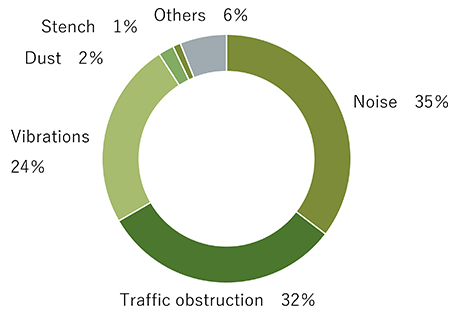- HOME
- Environment(E)
- Realization of a Sustainable and Environmentally Friendly Society
- Compliance with Environment-related Laws and Regulations
Compliance with Environment-related Laws and Regulations
Policies and Basic Approach / Goals and Targets
The first item in the Group Environmental Action Guidelines noted in the Environmental Policy is "Compliance with environment-related laws and regulations and achievement of zero environmental accidents: In addition to complying with environment-related laws and regulations throughout the Group, we will achieve 'Zero Environmental Accidents' at work sites based on the 'Priority Management Items for Work Sites' and other items set forth by the Safety Division." TAISEI continues to work to ensure zero environmental accidents (zero serious soil, water, dust or other pollution incidents) by observing environment-related laws and regulations and appropriately managing construction by-products.
Risks and Opportunities
In the event of a violation of an environment-related law or regulation at a TAISEI Group construction site, the risk of criminal penalties, administrative disciplinary action, claims for damages and so on will arise. TAISEI reduces the risk of environmental accidents and complaints during construction work by strictly observing environment-related laws and regulations and by promoting the use of work methods that reduce the impact of noise, vibrations, dust etc. on the surrounding environment.
Policies / Commitments
- Safety and Health Policy
- Key Environmental Management Manual
- Construction Byproduct Disposal Procedure Manual
Activities / Efforts
Risk Management at Worksites
To ensure appropriate disposal of construction by-products and observance of environmental laws, environmental safetydepartments at the Taisei head office and branch offices conduct "Worksite Environmental Patrols" and environmentaleducation and training as an internal audit of the observance of environmental laws and regulations at worksites.
Environmental education for employees and specialized construction company personnel is conducted at worksites inaccordance with the Key Environmental Management Items Manual. By sharing examples of situations that may lead led toenvironmental accidents, learning about the appropriate management of asbestos, PCBs and other hazardous chemicalsubstances, and by promoting appropriate management and purification of contaminated soil and so on, trainees learn theimportance of environmental management to prevent environmental accidents.
In FY2022, we conducted 1,219 environmental patrols. We also conducted inspections with more stringent targets than national laws and regulations, which led to the identification of 278 issues. Of these, 8 were nonconformities to environment-related laws and regulations. In response to the issues that were pointed out, we are devising corrective and preventive actions to ensure ongoing improvements.
In FY 2022, there were no incidents of soil, water, dust or other serious contamination, nor any serious environment-related legal violations.
Response
| Type | Action (Example) |
|---|---|
| Noise | Communicated with neighbors in advance about nighttime concrete-related work. |
| Vibration | Changed the heavy machinary work schedule in the factory to a factory holiday. |
| Dust | Implemented measures such as spraying water and installing sheets to avoid dust scattering from construction work. |
| Water pollution | collect fuel oil leaked from a crane ship using absorbent mat,and implemented recurrence prevention measure. |
*For worksites in central Tokyo, relevant precautions are being taken, such as continuous measuring of noise and vibration as well as display of such information externally in real time.
Complaints and Responses at Construction Sites and Offices
In response to environment-related companies addressed to construction sites and offices,we take appropriate measures record, and report using communication according to our sheet Environment Management System (EMS) procedure, and share the information horizontally among concerned departments or within the entire Company as necessary. we also respond appropriately to opinions/ comments received from civic groups.
Percentage by Complaint Item

